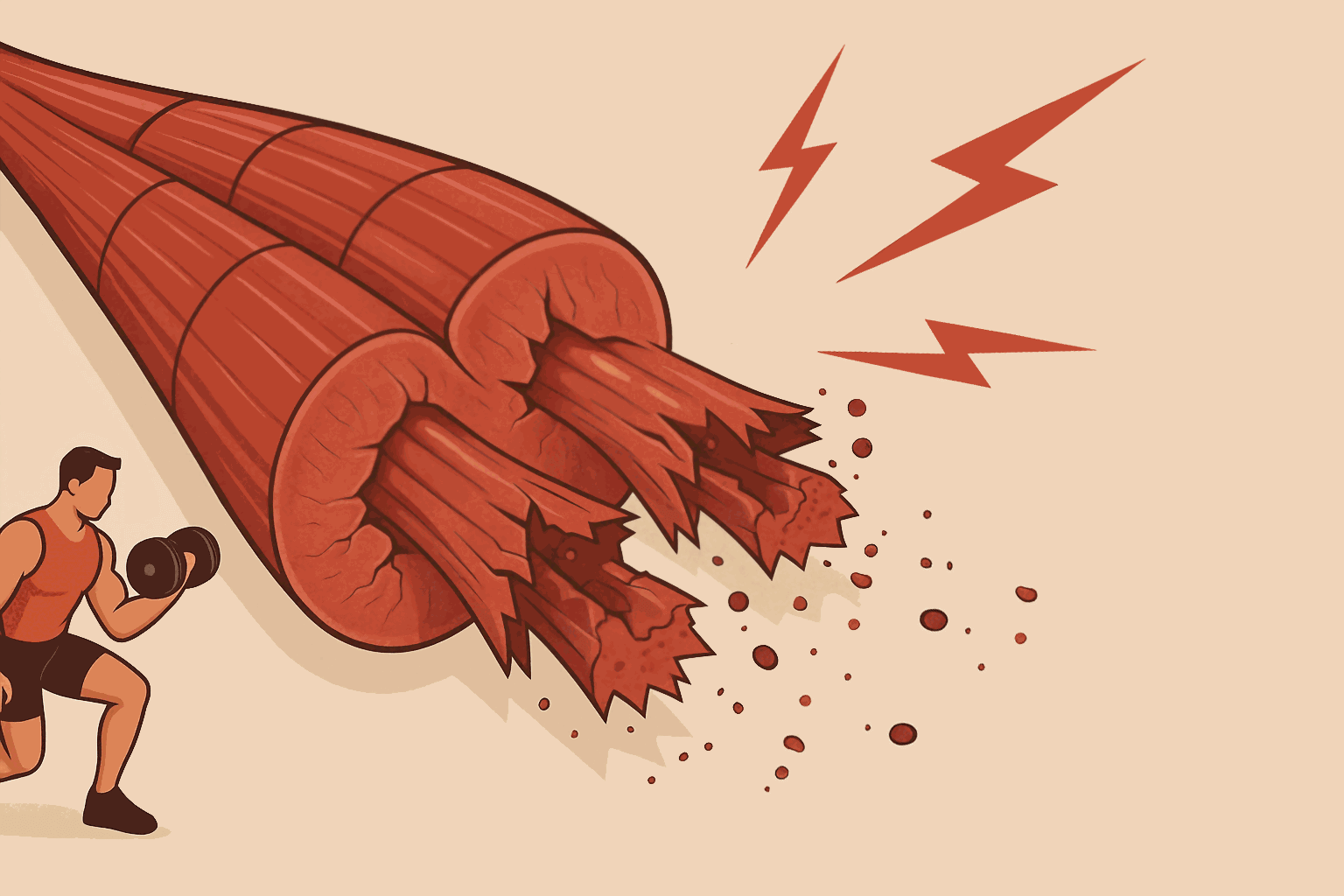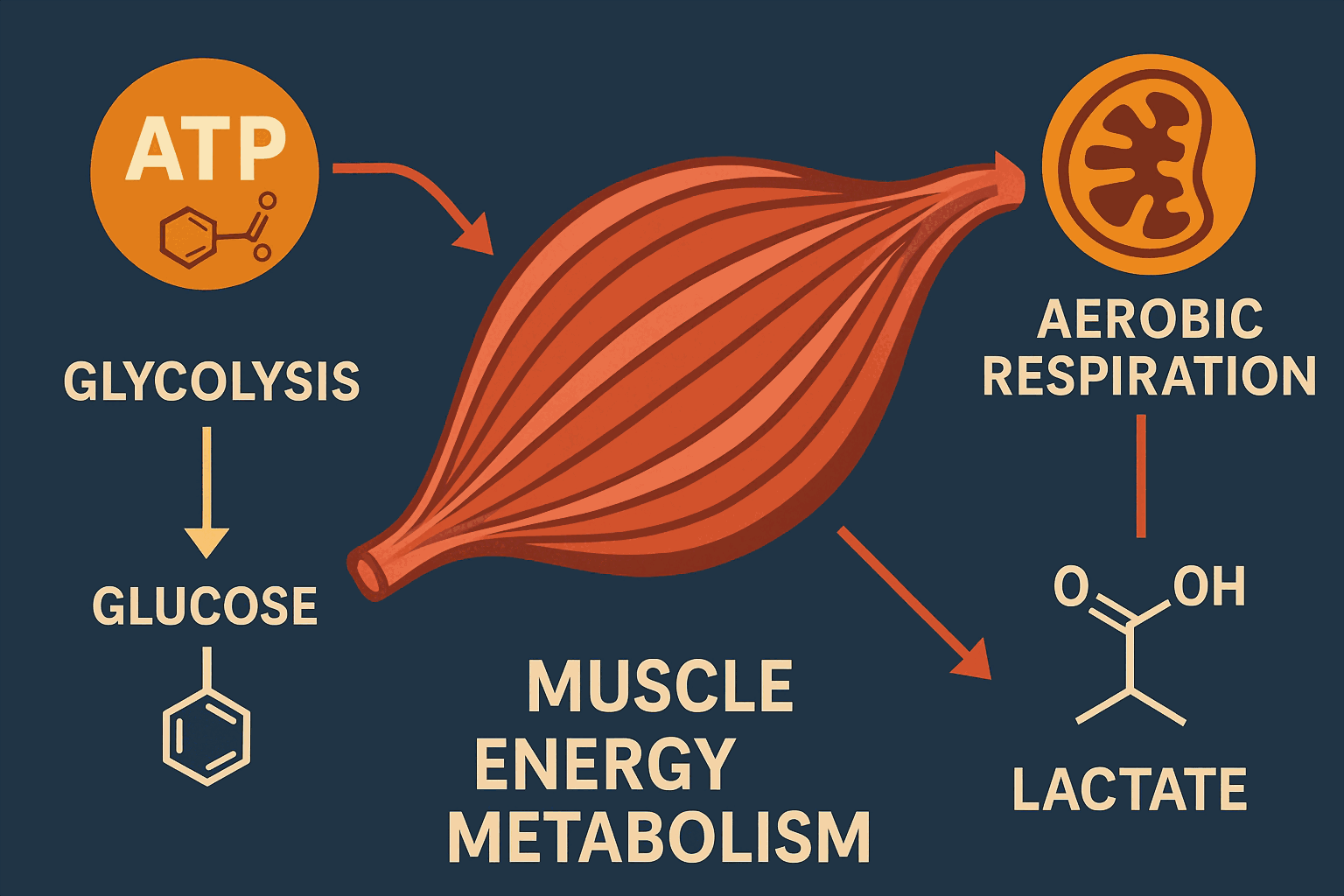
The Constructive Power of Muscle Microdamage in Strength Training
- Marcus Reed
- Exercise science , Physiology , Fitness , Strength training , Muscle health
- May 10, 2025
Table of Contents
Fast Facts: The Upside of Muscle Microdamage
- Growth Trigger: Microscopic tears in muscle fibers from strength training initiate repair processes that lead to muscle growth (hypertrophy).
- Stronger Fibers: The repair process not only fixes damage but also builds stronger, more resilient muscle fibers.
- Metabolic Increase: Healing damaged muscle tissue requires energy, boosting your metabolism even when you’re resting.
- Hormonal Advantage: Microdamage stimulates the release of key anabolic hormones like testosterone and growth hormone, aiding muscle development.
- Resilient Tissues: The stress of microdamage encourages the strengthening of connective tissues, reducing injury risk.
- Soreness is a Sign: Delayed Onset Muscle Soreness (DOMS) often indicates that muscles are adapting and growing stronger.
The idea that “damage” can be beneficial might seem counterintuitive. However, in the realm of strength training, microscopic damage to muscle fibers is not only expected but is a fundamental catalyst for muscle growth, increased strength, and enhanced physiological function. Today, we delve into the science behind muscle microdamage, exploring how these tiny tears are pivotal for building a stronger, more resilient you.
Understanding Muscle Microdamage: The Science
When you engage in strength training, particularly exercises involving high loads or eccentric contractions (like slowly lowering a weight), your muscle fibers are subjected to significant mechanical stress. This stress can lead to tiny, microscopic tears within the muscle fibers and their surrounding connective tissues. This phenomenon is known as exercise-induced muscle microdamage.
This isn’t the same as a muscle injury or strain, which involves more significant, often macroscopic, damage. Instead, microdamage is a controlled level of disruption that signals the body to initiate a sophisticated repair and reinforcement process. Research highlights that this damage is a key event in the adaptive response of muscles to exercise (Owens et al., 2021).
The Cascade of Benefits Triggered by Microdamage
Far from being detrimental, this controlled microdamage sets off a cascade of positive physiological responses:
1. Initiating Repair and Promoting Hypertrophy
The primary and most sought-after consequence of muscle microdamage is hypertrophy – an increase in the size of muscle fibers. Here’s how it unfolds:
- Cellular Response: Microdamage triggers an inflammatory response, attracting immune cells to the site. These cells clear out damaged tissue components.
- Satellite Cell Activation: Crucially, specialized muscle stem cells called satellite cells are activated. These cells proliferate and fuse with the damaged muscle fibers.
- Increased Myonuclei: By fusing with existing fibers, satellite cells donate their nuclei. More nuclei within a muscle fiber enhance its capacity for protein synthesis – the process of building new muscle proteins. This increased protein synthesis is essential for repairing the damage and, importantly, for adding new contractile proteins, making the muscle fiber thicker and stronger (Schoenfeld, 2010).
2. Boosting Overall Metabolism
The process of repairing and building muscle tissue is energetically demanding.
- Elevated Energy Expenditure: Your body expends a significant amount of calories to fuel the repair mechanisms, protein synthesis, and other adaptive processes following an intense workout. This contributes to an increase in your overall metabolic rate.
- Excess Post-exercise Oxygen Consumption (EPOC): Often referred to as the “afterburn effect,” EPOC describes the elevated oxygen uptake (and thus calorie expenditure) that occurs for hours, or even days, after a strenuous training session that causes microdamage. This “long-term increase in thermogenesis” helps with overall energy balance and can support fat loss goals.
3. Strengthening Connective Tissues
The stress that causes microdamage in muscle fibers also affects the surrounding connective tissues, such as tendons and fascia.
- Collagen Synthesis: In response to this stress, the body ramps up the synthesis of collagen and other structural proteins.
- Increased Resilience: This reinforcement of the connective tissue matrix makes your muscles, tendons, and ligaments more robust and resistant to future stress, thereby reducing the risk of injuries. This adaptation is crucial for long-term training consistency and performance (Kjaer, 2004).
4. Optimizing Hormonal Environment
Muscle microdamage sends signals that influence the endocrine system, leading to favorable hormonal adaptations:
- Anabolic Hormone Release: The body responds to the stress of intense exercise and subsequent microdamage by increasing the secretion of key anabolic (muscle-building) hormones. These include:
- Testosterone: Plays a vital role in muscle protein synthesis and repair.
- Insulin-like Growth Factor 1 (IGF-1): Promotes cell growth and proliferation, including muscle cells.
- Growth Hormone (GH): Stimulates protein synthesis, mobilizes fat for energy, and supports tissue repair.
- Supporting Growth and Recovery: This anabolic hormonal milieu created post-exercise is highly conducive to muscle hypertrophy, efficient recovery, and overall metabolic regulation.
The Role of DOMS (Delayed Onset Muscle Soreness)
Many who engage in strength training are familiar with Delayed Onset Muscle Soreness (DOMS) – the muscle pain and stiffness typically felt 24 to 72 hours after unaccustomed or intense exercise. DOMS is a common symptom associated with muscle microdamage and the subsequent inflammatory and repair processes.
While often uncomfortable, moderate DOMS is generally considered a normal indicator that your muscles have been sufficiently challenged to stimulate adaptation. It signifies that the repair crews are at work, laying the foundation for stronger, bigger muscles. However, it’s important to note that the absence of severe DOMS doesn’t necessarily mean a workout wasn’t effective, and excessively painful DOMS can be a sign of overdoing it.
Optimizing Recovery: The Key to Harnessing Microdamage Benefits
Experiencing muscle microdamage is only half the equation; proper recovery is paramount to reap the rewards. Without adequate rest and resources, the repair processes can falter, potentially leading to overtraining or injury.
- Strategic Periodization: Alternate between high-intensity workouts that cause microdamage and periods of lower intensity or rest. This allows your muscles adequate time to repair and adapt.
- Adequate Nutrition:
- Protein: Consume sufficient high-quality protein to provide the amino acid building blocks necessary for muscle repair and synthesis. Aim for regular intake throughout the day.
- Overall Calories: Ensure you’re eating enough total calories to fuel the energy-intensive recovery and growth processes.
- Micronutrients: Vitamins and minerals play crucial roles in cellular repair, energy metabolism, and immune function. A balanced diet is key.
- Quality Sleep: Sleep is when a significant portion of muscle repair and anabolic hormone release (like GH) occurs. Aim for 7-9 hours of quality sleep per night.
- Hydration: Water is essential for nearly all physiological processes, including nutrient transport, waste removal, and maintaining cellular integrity during recovery.
Microdamage vs. Injury: Knowing the Difference
It’s crucial to distinguish between beneficial, controlled muscle microdamage and an actual muscle injury (strain or tear). Microdamage occurs at a microscopic level and is a normal part of the adaptive process. An injury, on the other hand, involves more significant tissue disruption, often accompanied by acute pain, swelling, and loss of function, requiring more extensive recovery and potentially medical attention.
Listening to your body, employing proper exercise form, and progressing loads gradually are essential to ensuring you’re stimulating microdamage for growth, not causing overt injury.
Conclusion: Embrace the Adaptive Power of Microdamage
Muscle microdamage, far from being a negative outcome, is a fundamental and necessary stimulus for achieving significant gains in muscle strength, size, and overall physical resilience from strength training. By understanding this process, trainees can work with their physiology, implementing smart training strategies and prioritizing recovery to effectively harness the constructive power of these microscopic tears. This balance between challenging your muscles and allowing them to rebuild is the cornerstone of progressive and sustainable fitness.
Disclaimer
The information provided on BioBrain is intended for educational purposes only and is grounded in science, common sense, and evidence-based medicine. It is not a substitute for professional medical advice, diagnosis, or treatment. Always consult a qualified healthcare provider before making significant changes to your diet, exercise routine, or overall health plan.
References
- Owens, D. J., Twist, C., Cobley, J. N., Howatson, G., & Close, G. L. (2021) "Mechanisms of Exercise-Induced Muscle Damage, Repair, and Adaptation: A Narrative Review for Practitioners"
- Schoenfeld, B. J. (2010) "The mechanisms of muscle hypertrophy and their application to resistance training"
- Stokes, T., Hector, A. J., Morton, R. W., McGlory, C., & Phillips, S. M. (2018) "Recent perspectives regarding the role of dietary protein for promoting muscle hypertrophy with resistance exercise training"
- Kjaer, M. (2004) "Role of extracellular matrix in adaptation of tendon and skeletal muscle to mechanical loading"
- Hotfiel, T., Freiwald, J., Hoppe, M. W., Lutter, C., Forst, R., Grim, C., ... & Heiss, R. (2018) "Advances in Delayed-Onset Muscle Soreness (DOMS): Part I: Pathophysiology and Diagnostics"
- Damasc, M. C., Guedes, L. K. M., Karsten, M., & Lixandrão, M. E. (2021) "Resistance Training and Muscle Damage"
Tags :
- Muscle microdamage
- Strength training
- Hypertrophy
- Muscle recovery
- Doms
- Muscle growth
- Anabolic hormones
- Exercise physiology
- Metabolic boost
- Connective tissue


